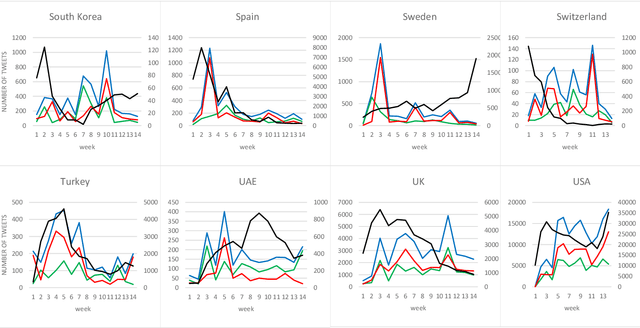Mahdi Hajiabadi
Extracting Feelings of People Regarding COVID-19 by Social Network Mining
Oct 12, 2021

Abstract:In 2020, COVID-19 became the chief concern of the world and is still reflected widely in all social networks. Each day, users post millions of tweets and comments on this subject, which contain significant implicit information about the public opinion. In this regard, a dataset of COVID-related tweets in English language is collected, which consists of more than two million tweets from March 23 to June 23 of 2020 to extract the feelings of the people in various countries in the early stages of this outbreak. To this end, first, we use a lexicon-based approach in conjunction with the GeoNames geographic database to label the tweets with their locations. Next, a method based on the recently introduced and widely cited RoBERTa model is proposed to analyze their sentimental content. After that, the trend graphs of the frequency of tweets as well as sentiments are produced for the world and the nations that were more engaged with COVID-19. Graph analysis shows that the frequency graphs of the tweets for the majority of nations are significantly correlated with the official statistics of the daily afflicted in them. Moreover, several implicit knowledge is extracted and discussed.
Detection of Community Structures in Networks with Nodal Features based on Generative Probabilistic Approach
Dec 24, 2019



Abstract:Community detection is considered as a fundamental task in analyzing social networks. Even though many techniques have been proposed for community detection, most of them are based exclusively on the connectivity structures. However, there are node features in real networks, such as gender types in social networks, feeding behavior in ecological networks, and location on e-trading networks, that can be further leveraged with the network structure to attain more accurate community detection methods. We propose a novel probabilistic graphical model to detect communities by taking into account both network structure and nodes' features. The proposed approach learns the relevant features of communities through a generative probabilistic model without any prior assumption on the communities. Furthermore, the model is capable of determining the strength of node features and structural elements of the networks on shaping the communities. The effectiveness of the proposed approach over the state-of-the-art algorithms is revealed on synthetic and benchmark networks.
* 12 pages, 13 figures, 6 tables
IEDC: An Integrated Approach for Overlapping and Non-overlapping Community Detection
Feb 13, 2017



Abstract:Community detection is a task of fundamental importance in social network analysis that can be used in a variety of knowledge-based domains. While there exist many works on community detection based on connectivity structures, they suffer from either considering the overlapping or non-overlapping communities. In this work, we propose a novel approach for general community detection through an integrated framework to extract the overlapping and non-overlapping community structures without assuming prior structural connectivity on networks. Our general framework is based on a primary node based criterion which consists of the internal association degree along with the external association degree. The evaluation of the proposed method is investigated through the extensive simulation experiments and several benchmark real network datasets. The experimental results show that the proposed method outperforms the earlier state-of-the-art algorithms based on the well-known evaluation criteria.
 Add to Chrome
Add to Chrome Add to Firefox
Add to Firefox Add to Edge
Add to Edge